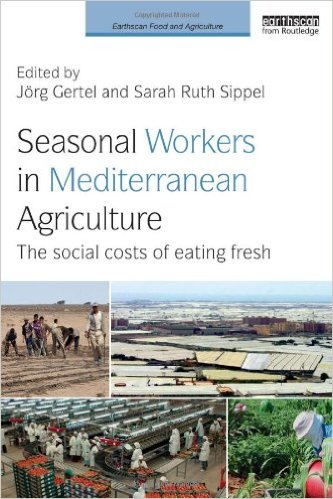With the trade of fresh fruit and vegetables becoming one of the fastest growing food sectors worldwide, farm sizes increase and food standards become globalized and influenced by supermarkets and buyers. Meanwhile, the character of agricultural labor is pressured by these same forces, often at the expense of sustainable agricultural techniques and more autonomous ways of life. These phenomena are examined in Jörg Gertel and Sarah Ruth Sippel’s edited volume, Seasonal Workers in Mediterranean Agriculture: The social costs of eating fresh (Routledge and Earthscan, 2014), which takes France, Spain and Morocco as specific examples, and draws additional case studies from Canada, New Zealand and the Philippines.
Seasonal Workers is organized into five parts, with an introduction, a conclusion, and France, Spain and Morocco each provided with its own part. The volume’s stated objectives are: 1) to provide an empirically grounded and historically embedded analysis of cross-continental exchange of agriculture products and labor; 2) to investigate the spaces of insecurity that are inscribed into intensive agricultural production while pointing to vulnerabilities and social ruptures; and 3) to narrate the story of the social life of fruits and vegetables (pp. 4-5). The text also examines how products and people move across state borders in accordance with regulations and lived realities that serve to both erase and re-inscribe the region’s borders yet present it as a space that is unified yet fractured by the flows of people and fresh fruits and vegetables.
Traditionally, the Mediterranean region is a hub of migrant labor largely drawn from North African countries recruited to work in intensive horticultural production. As Mesini’s contribution in Seasonal Workers shows, however, new forms of contracting have begun substituting Moroccan and Tunisian workers with Latin American temporary workers through new transnational, temporary contracting arrangements that are facilitated by large temp employment agencies such as Terra Fecundis in Spain. Barber’s commentary provides Philippines-Canada comparisons to help demonstrate the exploitation and insecurity that pervade all aspects of migrant worker experiences, presenting examples of how the diversity of contracts issued to workers has created intensified competition for work among migrant groups as such contracts distinguish and privilege workers by national origin and gender.
Lindner and Kathmann’s chapter illustrates similar tensions within countries of origin, where contract labor recruitment practices lead to social and legal inequalities that increase the pressures upon unemployed workers to accept poor working conditions. They take Spain as a case study where, up until the 1990s, the majority of agricultural workers were Spanish, but where labor is now contracted from 22 countries around the world—Romanians today making up the largest group of migrant workers followed by Moroccans and Ecuadorians. Constance’s contribution shows how Moroccans—most especially Moroccan women—have increasingly begun replacing Romanian workers in Spain since the economic crisis of 2007, as Romanian workers are generally better educated and may benefit from EU protections not available to North African workers. Indeed, in Spain, agricultural workers are generally exploited by not being paid for the hours worked, by receiving wages that are among the lowest in the country, in lacking the legal protections of citizen workers, and by generally living in substandard urban housing.
Barbesgaard and Fold illustrate how the intensification of export-driven fruit and vegetable production from Morocco into the EU has threatened national food sovereignty and converted small farmers into wage laborers within vertically integrated operations of citrus plantations and plastic greenhouses. Sippel contributes a view on how Moroccan women are hired for packing and sorting such produce because they are understood as having “gentler hands” and perceived to “work more carefully.” The workforce in Moroccan strawberry cultivation is thus predominately made up of young, uneducated women drawn from the rural poor, while packing-house workers are made up of older and married women. And as more of Morocco’s rural and herding population is increasingly transformed into dispossessed pastoralists, they increasingly turn to agricultural wage work to survive as small-scale production, with women making up an important part of this agricultural migrant population. We are thus confronted with important evidence as to how Morocco’s local and regional food economies have been shaped to serve consumer demands in the EU.
As Seasonal Workers reveals, intensive fresh fruit and vegetable production is dependent upon seasonal migrant workers, whose wages remain low, whose work is devalued and underpaid, and whose lives are precarious. The volume’s contributions also demonstrate that agro-industrial development in the Mediterranean has disadvantaged small-scale farmers and herders, shaped competition among migrant workers, become dependent upon women’s labor, and increased the rural poor’s vulnerability. The volume makes the lives and livelihoods of agricultural workers visible within the geography of agro-industrial production, allowing us to confront the contradictions of a region symbolizing healthy eating through the paradigm of a Mediterranean diet that focuses on the consumption of fruits and vegetables, yet pits agricultural workers from three continents against one another, makes labor organization and advocacy increasingly challenging due to language barriers and the competition for employment, and deploys the citizen/non-citizen hierarchy to shape advantage and disadvantage among gendered groups.



